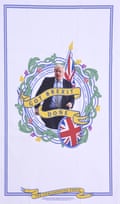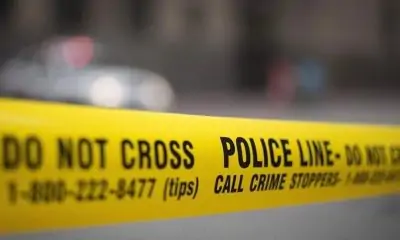Art
Liberty, equality … embroidery: the political power of textile art – The Guardian
Embroidery, weaving and fabric decoration have often been dismissed as crafts rather than arts, relegated to “women’s work”. But a series of exhibitions this summer casts new light on the political power and importance of textiles in all their forms, from Brexit tea towels to dresses embellished with symbolic patterns.
Palestinian embroidery is the focus of the exhibition Material Power at Kettle’s Yard, Cambridge, and its evolution from tradition to a form of political protest. Threads is a group show at Bristol’s Arnolfini that covers postcolonialism, migration and gender in its displays of weaving, knitting and stitching – including work by artists Anya Paintsil and Raisa Kabir.
Textile artist Alice Kettle is co-curator of Threads. Kettle won this year’s Brookfield Properties Craft Award and also has a solo show, To Boldly Sew, in London.

All three shows run until the autumn, when The Fabric of Democracy opens at the Fashion and Textile Museum in London. This delves into the history of how fabric manufacturers and designers create works of political propaganda. Then there’s the British Textile Biennial, held in Lancashire. Artists are exhibiting work inspired by “textile waste colonialism”. Victoria Udondian, Jeremy Hutchison and Sunny Dolat of Nest Collective are all addressing the western practice of dumping unwanted textiles in countries such as Ghana and Chile.
Fashion historian Amber Butchart is associate curator for the biennial and curator of The Fabric of Democracy. She says: “Historically, in Europe and America, textiles were dismissed by the patriarchal art establishment as inferior to painting and sculpture, which have been prioritised in galleries. Textiles have long been viewed as ‘only’ decorative, even though feminist artists and scholars such as Judy Chicago and Louise Bourgeois have questioned this.”
Butchart says that activist messages are also commonly associated with public rather than domestic spaces. She wants to show how furnishings and fashion can be political. Fabric of Democracy includes Chinese quilts – dahua beimian – decorated with symbols during the Cultural Revolution such as factory chimneys and scientific equipment. There’s also a ‘‘Got Brexit Done” tea towel, which was, briefly, official Conservative party merchandise when the UK left the EU in January 2020.
“It features an image of unity even though Scotland and Northern Ireland voted to remain in the EU,” says Butchart.

The Material Power exhibition features clothing as items of political protest and gives important space to an underrepresented group. “Palestinian women are not people that we think of as having historical record,” says the show’s curator, Rachel Dedman. “But the things they make have a fascinating and powerful connection to the political realities in which they live.”
Garments on display feature motifs such as doves clutching guns in their claws and the letters PLO stitched into traditional designs. The colours of the Palestinian tricolour were used in clothes made in the early 80s, a time when it was forbidden to fly the flag.
“These textiles defy what we think of as the material culture of protest,” says Dedman. “We normally think of scrawled signs and banners, but these have taken years to make with each stitch done by hand. The notion of steadfastness is central to the Palestinian resistance, and I think this embroidery embodies that.”

Alice Kettle, professor of textile arts at Manchester School of Art, says she felt she could speak more powerfully through textiles and stitching than any other artistic medium. “It lets me be authentic and myself.”
Kettle thinks that the pandemic ushered in a more widespread interest in making and also a better understanding of the therapeutic side of handcrafting. “People realised there’s a broader aspect to the arts, that they help us shift our focus on the world.”
She also points out that our western-centric view of the arts is irrelevant to many nations. “There isn’t that definition of fine-art practice – art is about creativity and that’s normally bound up in materials.”
Many British institutions are currently looking at the legacy of colonialism in their collections and featuring a wider range of creatives, especially female artists. “I think there’s a wider appreciation for telling women’s stories,” says Dedman. “This goes hand in hand with textile art.”
Butchart also thinks the trend for shows about materials and protest are a sign that our view of culture is changing.
“Textiles and clothing are deeply woven into the cultural heritage of humanity. Adorning the body has always been a means of communication. I think it’s great that museums and galleries are catching up.”
Art
Calvin Lucyshyn: Vancouver Island Art Dealer Faces Fraud Charges After Police Seize Millions in Artwork

In a case that has sent shockwaves through the Vancouver Island art community, a local art dealer has been charged with one count of fraud over $5,000. Calvin Lucyshyn, the former operator of the now-closed Winchester Galleries in Oak Bay, faces the charge after police seized hundreds of artworks, valued in the tens of millions of dollars, from various storage sites in the Greater Victoria area.
Alleged Fraud Scheme
Police allege that Lucyshyn had been taking valuable art from members of the public under the guise of appraising or consigning the pieces for sale, only to cut off all communication with the owners. This investigation began in April 2022, when police received a complaint from an individual who had provided four paintings to Lucyshyn, including three works by renowned British Columbia artist Emily Carr, and had not received any updates on their sale.
Further investigation by the Saanich Police Department revealed that this was not an isolated incident. Detectives found other alleged victims who had similar experiences with Winchester Galleries, leading police to execute search warrants at three separate storage locations across Greater Victoria.
Massive Seizure of Artworks
In what has become one of the largest art fraud investigations in recent Canadian history, authorities seized approximately 1,100 pieces of art, including more than 600 pieces from a storage site in Saanich, over 300 in Langford, and more than 100 in Oak Bay. Some of the more valuable pieces, according to police, were estimated to be worth $85,000 each.
Lucyshyn was arrested on April 21, 2022, but was later released from custody. In May 2024, a fraud charge was formally laid against him.
Artwork Returned, but Some Remain Unclaimed
In a statement released on Monday, the Saanich Police Department confirmed that 1,050 of the seized artworks have been returned to their rightful owners. However, several pieces remain unclaimed, and police continue their efforts to track down the owners of these works.
Court Proceedings Ongoing
The criminal charge against Lucyshyn has not yet been tested in court, and he has publicly stated his intention to defend himself against any pending allegations. His next court appearance is scheduled for September 10, 2024.
Impact on the Local Art Community
The news of Lucyshyn’s alleged fraud has deeply affected Vancouver Island’s art community, particularly collectors, galleries, and artists who may have been impacted by the gallery’s operations. With high-value pieces from artists like Emily Carr involved, the case underscores the vulnerabilities that can exist in art transactions.
For many art collectors, the investigation has raised concerns about the potential for fraud in the art world, particularly when it comes to dealing with private galleries and dealers. The seizure of such a vast collection of artworks has also led to questions about the management and oversight of valuable art pieces, as well as the importance of transparency and trust in the industry.
As the case continues to unfold in court, it will likely serve as a cautionary tale for collectors and galleries alike, highlighting the need for due diligence in the sale and appraisal of high-value artworks.
While much of the seized artwork has been returned, the full scale of the alleged fraud is still being unraveled. Lucyshyn’s upcoming court appearances will be closely watched, not only by the legal community but also by the wider art world, as it navigates the fallout from one of Canada’s most significant art fraud cases in recent memory.
Art collectors and individuals who believe they may have been affected by this case are encouraged to contact the Saanich Police Department to inquire about any unclaimed pieces. Additionally, the case serves as a reminder for anyone involved in high-value art transactions to work with reputable dealers and to keep thorough documentation of all transactions.
As with any investment, whether in art or other ventures, it is crucial to be cautious and informed. Art fraud can devastate personal collections and finances, but by taking steps to verify authenticity, provenance, and the reputation of dealers, collectors can help safeguard their valuable pieces.
Art
Ukrainian sells art in Essex while stuck in a warzone – BBC.com
[unable to retrieve full-text content]
Ukrainian sells art in Essex while stuck in a warzone BBC.com

Source link
Art
Somerset House Fire: Courtauld Gallery Reopens, Rest of Landmark Closed
The Courtauld Gallery at Somerset House has reopened its doors to the public after a fire swept through the historic building in central London. While the gallery has resumed operations, the rest of the iconic site remains closed “until further notice.”
On Saturday, approximately 125 firefighters were called to the scene to battle the blaze, which sent smoke billowing across the city. Fortunately, the fire occurred in a part of the building not housing valuable artworks, and no injuries were reported. Authorities are still investigating the cause of the fire.
Despite the disruption, art lovers queued outside the gallery before it reopened at 10:00 BST on Sunday. One visitor expressed his relief, saying, “I was sad to see the fire, but I’m relieved the art is safe.”
The Clark family, visiting London from Washington state, USA, had a unique perspective on the incident. While sightseeing on the London Eye, they watched as firefighters tackled the flames. Paul Clark, accompanied by his wife Jiorgia and their four children, shared their concern for the safety of the artwork inside Somerset House. “It was sad to see,” Mr. Clark told the BBC. As a fan of Vincent Van Gogh, he was particularly relieved to learn that the painter’s famous Self-Portrait with Bandaged Ear had not been affected by the fire.
Blaze in the West Wing
The fire broke out around midday on Saturday in the west wing of Somerset House, a section of the building primarily used for offices and storage. Jonathan Reekie, director of Somerset House Trust, assured the public that “no valuable artefacts or artworks” were located in that part of the building. By Sunday, fire engines were still stationed outside as investigations into the fire’s origin continued.
About Somerset House
Located on the Strand in central London, Somerset House is a prominent arts venue with a rich history dating back to the Georgian era. Built on the site of a former Tudor palace, the complex is known for its iconic courtyard and is home to the Courtauld Gallery. The gallery houses a prestigious collection from the Samuel Courtauld Trust, showcasing masterpieces from the Middle Ages to the 20th century. Among the notable works are pieces by impressionist legends such as Edouard Manet, Claude Monet, Paul Cézanne, and Vincent Van Gogh.
Somerset House regularly hosts cultural exhibitions and public events, including its popular winter ice skating sessions in the courtyard. However, for now, the venue remains partially closed as authorities ensure the safety of the site following the fire.
Art lovers and the Somerset House community can take solace in knowing that the invaluable collection remains unharmed, and the Courtauld Gallery continues to welcome visitors, offering a reprieve amid the disruption.
-

 Sports19 hours ago
Sports19 hours agoKirk’s walk-off single in 11th inning lifts Blue Jays past Cardinals 4-3
-

 Sports19 hours ago
Sports19 hours agoCanada’s Marina Stakusic falls in Guadalajara Open quarterfinals
-

 Sports20 hours ago
Sports20 hours agoStampeders return to Maier at QB eyeing chance to get on track against Alouettes
-

 News23 hours ago
News23 hours agoKingston mayor’s call to close care hub after fatal assault ‘misguided’: legal clinic
-

 Sports23 hours ago
Sports23 hours agoWhitehead becomes 1st CHL player to verbally commit to playing NCAA hockey
-

 News20 hours ago
News20 hours agoMetro Vancouver’s HandyDART strike continues after talks break with no deal
-

 News20 hours ago
News20 hours ago26-year-old son is accused of his father’s murder on B.C.’s Sunshine Coast
-

 News2 hours ago
News2 hours agok.d. lang gets the band back together for Canadian country music awards show





















